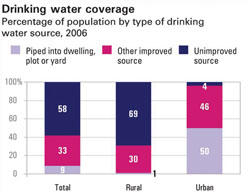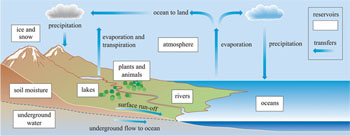Use 'Print preview' to check the number of pages and printer settings.
Print functionality varies between browsers.
Printable page generated Saturday, 22 November 2025, 1:41 PM
Hygiene and Environmental Health Module: 13. Provision of Safe Drinking Water
Study Session 13 Provision of Safe Drinking Water
Introduction
Water is essential for life. An adequate, safe and accessible water supply must be available to all people, and improving access to safe drinking water can result in tangible benefits to health. Water is one of the factors which contribute to the transmission of many diseases. In this study session, you will learn and understand about the public health importance of water, the water (hydrological) cycle, the basic requirements for a safe, adequate and accessible drinking water supply, and the obstacles to safe water provision. You will also learn about different indicators for safe, adequate and accessible water supply. This study session will help you to recognise the basic requirements for safe water supply and to understand the transmission of waterborne diseases.
Learning Outcomes for Study Session 13
When you have studied this session, you should be able to:
13.1 Define and use correctly all of the key words printed in bold. (SAQs 13.1 and 13.3)
13.2 Describe the various types of disease associated with water. (SAQ 13.2)
13 3 Describe the hydrological cycle. (SAQ 13.3)
13.4 List and describe the basic requirements for safe, adequate and accessible drinking water. (SAQ 13.4)
13.5 Identify the groups of people who are particularly vulnerable to the lack of provision of safe water. (SAQ 13.5)
13.6 Describe the barriers to the provision of safe water. (SAQ 13.6)
13.1 The public health importance of water
We begin this study session by describing the public health significance of water. A satisfactory water supply must be available to all humans. By ‘satisfactory’ we mean water must be available in adequate quantity, be safe to drink and be accessible. Improving access to safe drinking water can result in tangible benefits to health so every effort should be made to achieve drinking water quality that is as safe as is practicably possible.
The great majority of water-related health problems are the result of microbial (bacteriological, viral, protozoan or other biological) contamination. Infectious waterborne diseases such as diarrhoea, typhoid and cholera are leading causes of death and illness in the developing world. There are many diseases associated with water, which can be classified as waterborne, water-washed, water-based and water-related (Box 13.1).
Box 13.1 Diseases associated with water
Several terms are used to describe the types of disease associated with water. These are:
Waterborne diseases are those caused by ingestion of water that is contaminated by human or animal excrement and contains pathogenic microorganisms. Transmission occurs by drinking contaminated water. Waterborne diseases include most of the enteric and diarrhoeal diseases caused by bacteria and viruses, including cholera, typhoid and bacillary dysentery. They also include diseases caused by protozoa (single-celled microorganisms) such as giardiasis, amoebic dysentery and cryptosporidiosis.
Water-washed diseases are caused by poor personal hygiene, and skin and eye contact with contaminated water. They are also sometimes known as water-scarce diseases because they occur when there is not enough water available for adequate personal washing. They include scabies, trachoma, typhus, and other flea, lice and tick-borne diseases.
Water-based diseases are caused by parasites that spend part of their lifecycle in water. For example, schistosomiasis and dracunculiasis are both water-based diseases caused by helminths (parasitic worms). Schistosomiasis (also known as bilharzia) is caused by a worm that spends part of its lifecycle in the body of a particular species of water snail. People can become infected from swimming or wading in infected water. Dracunculiasis or guinea worm is transmitted by drinking water that is contaminated with copepods (very small crustaceans) that contain the larvae of the worm.
Water-related diseases are caused by insect vectors, especially mosquitoes, that breed or feed near water. They are not typically associated with lack of access to clean drinking water or sanitation services. Water-related diseases include dengue fever, filariasis, malaria, onchocerciasis, trypanosomiasis and yellow fever.
Note that, rather confusingly, the term ‘water-related’ is sometimes used to mean all the above, i.e. all diseases associated with water.
Chemical contamination of water is another potential cause of health problems. In some places, water may contain naturally occurring toxic chemicals such as arsenic and fluoride. Other chemicals may get into the water supply because of pollution. Lead poisoning, for example, can result from water contaminated with lead. These diseases are also classified as waterborne diseases.
Safe water is water which is free from disease-causing agents and does not have any significant risk to health over a lifetime of consumption. The term potable water is also sometimes used; ‘potable’ means safe to drink. A related but different term is palatable water, which means water that is pleasant to drink. Palatable water is at a desirable temperature, completely transparent and free from tastes, odours and colours, but is not necessarily free from disease-causing agents. Safe drinking water is suitable for all usual domestic purposes, including personal hygiene. Access to safe and affordable water is considered to be a basic human right.
Many million individuals in Ethiopia have to get their water from unsafe sources and this makes them vulnerable to waterborne disease. Figure 13.1 shows the relative proportions of people in Ethiopia with access to improved and unimproved sources (see also Box 13.2).
Look at the bar graph in Figure 13.1. What proportion of the rural population in Ethiopia obtains their water from unimproved sources? And what proportion of the urban population?
69% of the rural population and 4% of the urban population get their water from unimproved sources.
Box 13.2 Water sources
Water source simply means water in its natural environment that is used by people to meet their need for water. Common water sources are groundwater, surface water such as rivers and lakes, spring water, and rainwater.
Water sources can be described as protected or unprotected. Unprotected sources are those where there is no barrier or other structure to protect the water from contamination. Protected sources, on the other hand, are covered by stonework, cement or other material that prevents the entry of any physical, chemical or biological contaminant. Water from a protected source is likely to be safe to drink but water from unprotected sources cannot be considered safe.
The terms improved and unimproved sources may also be used, as in Figure 13.1. These terms are broadly equivalent to protected and unprotected. Improved drinking water sources include household connections, public standpipes and water points, boreholes, protected dug wells, protected springs and rainwater collections. Unimproved water sources include rivers, lakes, unprotected wells and unprotected springs.
Using the data in Figure 13.1, in general terms, what fraction of the rural Ethiopian population uses an unimproved water source?
69% of rural people use an unimproved water source. This is roughly equivalent to two-thirds of the population (two-thirds equals 66.7%).
The provision of safe water and sanitation is not only essential for disease prevention, it is also a key mechanism required to break the cycle of poverty, particularly for women and girls. Lack of access to water may limit the use of latrines because the need for handwashing creates an additional water requirement and therefore an additional burden on the person responsible for collecting water. With improved access to safe water, women and girls have more time to tend to crops and livestock, more time and resources to spend on improved food preparation, more time to attend school, and an opportunity to participate in the local economy. These are all mechanisms for breaking the cycle of poverty.
13.2 The uses of safe water
13.2.1 For drinking
All individuals need water for drinking every day. Inadequate consumption of water, either by drinking or through food, can lead to dehydration of the body and ultimately to death. The water requirement of individuals for drinking and food preparation will vary according to diet, climate and the type of work they do. Pregnant women and breastfeeding mothers need more water than other people. The minimum amount of water needed for survival ranges from about 2 litres per capita per day in temperate climates to about 4.5 litres for people in hot climates who have to carry out manual work.
Per capita means per person or per head of population
13.2.2 For food preparation and cooking
Water is an ingredient of many foodstuffs and is also needed for food hygiene to make certain that food is safe to eat. Most people need at least 2 litres of safe water per day for food preparation.
13.2.3 For hygiene
Providing safe water and encouraging people to practise good hygiene will achieve massive health benefits. For example, the Shigella bacterium causes dysentery or bloody diarrhoea and it is a major contributor to the millions of water-related deaths each year. However, the simple step of washing hands with soap and water will significantly reduce shigellosis and other diarrhoeal diseases. Moreover, providing clean water for washing can prevent trachoma, which is the leading cause of preventable blindness.
Why is hand hygiene so important for reducing communicable diseases?
Our hands can be soiled by many different contaminants, for example, while visiting a toilet, during farming activities, cleaning children’s bottoms and so on; hence washing hands with soap and water is very important.
13.3 The hydrological cycle
Water is in plentiful supply on our planet but most of it is not available for human use. Over 97% of the world’s water is in the oceans and is salty. Fresh water, found in rivers, lakes and within the ground, accounts for less than 1% of the total (Figure 13.2). It is not distributed evenly around the world. There is a surplus in some places and scarcity in others.
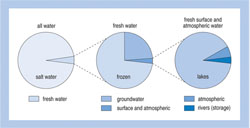
Water is in continuous motion in a series of processes called the hydrological cycle or water cycle that governs the health of the planet. (Hydrology is the study of water, hence the alternative name for the water cycle.) Figure 13.3 shows a diagram of the water cycle. Without continuous evaporation from the oceans, precipitation on land and runoff back to the oceans, there would be no recharge (replacement) of surface and groundwater.
There are several important terms here that need explanation. Evaporation is the change from a liquid to a gas. When the sun shines on the surface of water, water molecules evaporate from the water body into the atmosphere above. Precipitation simply means water falling from the atmosphere to the Earth’s surface; mostly this means rain, although it also includes snow. Runoff includes all water that flows, under the force of gravity, across land in streams and rivers and across the surface, for example, of a field. Groundwater includes all water that is found underground within the rocks; some groundwater may be near the surface and some may be deep underground.
In Figure 13.3, the transfers (the movements or flows) of water are shown as arrows and the reservoirs (stores) as boxes. Note that the word ‘reservoirs’, in general speech, refers to artificial lakes that have been constructed to store water at the surface. In the context of the water cycle and hydrology, reservoir means all stores of water. Another term included in Figure 13.3 is transpiration, which is the release of water vapour (water as a gas) from plants and soils into the atmosphere. Evaporation and transpiration are sometimes referred to together as evapotranspiration.
13.4 Criteria for satisfactory water
What are the three main criteria for ‘satisfactory’ water supply?
Satisfactory water means water that is available in adequate quantity, is safe to drink and is accessible.
Human beings have a right to have clean, safe water. Several criteria need to be satisfied to ensure that the people in your community have satisfactory access to water. These are discussed on the following pages.
13.4.1 Sufficient quantity
According to international and national guidelines, the quantity of water available in each household should be 50–100 litres per person per day, or an absolute minimum of 20 litres. In practice, the amount of water collected every day by households is considerably less than this and is largely determined by the distance of the source of water from the home. If the water source is outside the home, but within around 1 kilometre (or 30 minutes total collection time), about 20 litres per person per day will typically be collected.
Where water is supplied through a single tap within the confines of the household’s living area, the water used is typically about 50 litres per person per day. At this level it is much easier to ensure good hygiene. For example, households may use 30 times more water for child hygiene compared with those who have to collect water from a communal source. Households that do not have to travel to collect water have more time for economic activity, food preparation, child care and education. Having access to a greater volume of water potentially encourages handwashing, general physical cleanliness and improved living conditions.
13.4.2 Safe and acceptable
Water must be safe for drinking and other household uses. Drinking water must be free from microbes and parasites, and free from chemical and physical contaminants that constitute a danger to a person’s health. It must also be acceptable in terms of colour and odour.
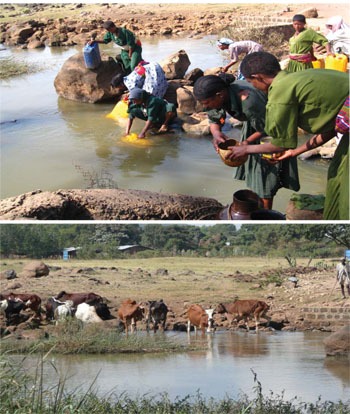
The two photos in Figure 13.4 were taken at the same place. Do you think that water from the river in Figure 13.4 would be safe to drink? Is this an example of a protected or unprotected source?
This river is likely to be contaminated with animal dung, urine and possibly other pollutants. It is not advisable to use this water for drinking and cooking without any treatment. The river is an unprotected source; there is nothing to protect the water from contamination.
13.4.3 Physically accessible
Water must be within safe physical reach, in or near the house, school or health facility. Accessibility to safe water can be classified as follows:
No access. You would say people do not have access to safe water when:
- The distance to the water source is more than one kilometre or more than a 30-minute round trip.
- The amount of water collected is very low (often below 5 litres per capita per day).
Basic access (see Figure 13.5). You would say people have a basic level of access to safe water when:
- The water source is within one kilometre/30-minute round trip.
- The amount of water to be collected on average is unlikely to exceed 20 litres per capita per day.
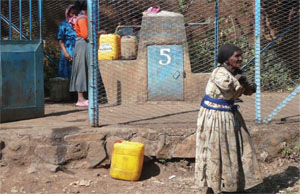
Intermediate access (see Figure 13.6). You would say people have an intermediate level of access to safe water when:
- Water is provided onsite through at least one tap (at yard level).
- Average volume of water collected is approximately 50 litres per capita per day.
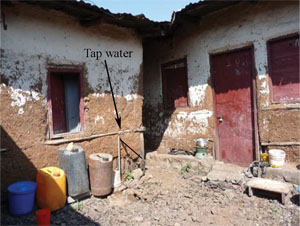
Optimal access. You would say people have optimal access to safe water when:
- Supply of water is through multiple taps within the house.
- Approximately 100–200 litres per capita per day or more is available.
Earlier in this session it was said that the daily minimum water requirement was between 2 and 4.5 litres per person per day according to climate conditions. Why does this differ from any of the average consumption figures quoted above?
Because the average consumption refers to water used for all household purposes including washing, cooking and cleaning as well as drinking and eating. The requirement of 2 to 4.5 litres per person per day is the volume of water that must be consumed by a person to survive.
13.4.4 Affordable
As well as being physically accessible, water should also be reasonably priced and affordable for everyone. Buying water should not reduce a person’s capacity to buy other essential goods. This means that essential amounts of water must sometimes be provided free according to the socioeconomic strength of the communities. Ensuring the affordability of water requires that services match what people can pay. For example, in most rural communities of Ethiopia protected water sources are freely provided by the government and other organisations.
13.5 Vulnerability due to lack of satisfactory water provision
As you know, the poor are among those most directly affected by unsafe water. They are not only less likely to have access to safe water and sanitation, but they are also less likely to have the financial and human resources to manage the impact of this deficiency. The majority of those who have no access to improved sources of drinking water are the rural poor. This lack of access is reflected in the day-to-day investment of time to collect water which means that women, in particular, do not have time for productive activity, for household tasks, for childcare or for education.
As well as the dangers arising from using water from unprotected sources, women’s health may also be affected by the heavy burden of carrying water because carrying heavy loads may cause spinal injuries. Furthermore, women who collect water may be physically attacked while performing this task. Women also suffer from the lack of appropriate sanitation facilities. When there is little privacy or security for them, women and girls have to go into an inappropriate location where they may risk being attacked. Water facilities and services must be culturally appropriate and sensitive to gender, and privacy requirements.
Infants and children are particularly vulnerable to the lack of safe water provision. Lack of accessible safe water increases their vulnerability to diseases. Their immune systems are not fully developed and may not be able to respond to a water-related infection. They also have less body mass than adults, which means that a waterborne chemical may be dangerous for a child at a concentration that is relatively harmless for an adult. Children often share with women the responsibility for fetching water. This means they may miss school and it can affect their health and put them, especially girls, at risk of harassment. Other groups who may be more vulnerable to a lack of safe water include people who are ill or debilitated in some way because their immune system may already be weakened. The elderly may also be at greater risk.
13.6 Future impacts on provision of water
13.6.1 Population dynamics
Rapid population growth puts increasing pressure on our limited resources. The percentage of young children is increasing within the Ethiopian population. In 2007, a Central Statistics Agency report estimated the Ethiopian population as 73 million, of whom about half are under 15 years of age. This means an increase in the proportion of the total population at highest risk from infectious waterborne diseases (gastrointestinal illnesses disproportionately affect the health of the very young and very old).
The general increase in population means that more and more land is brought into use to support the growing number of people. This can have a serious impact on the environment and also on water resources. There is a close relationship between land use, and water quality and quantity. If land is cleared of natural vegetation, water will run off the surface more quickly and will not soak into the soil. This not only reduces the amount of soil water available for plant growth it also reduces replenishment of groundwater reservoirs. The water flows off into rivers before it has penetrated into the ground. The increased runoff resulting from loss of vegetation also causes soil erosion, especially in the rainy season, because the soil is washed away into the rivers. Erosion is especially likely on slopes and where the ground is ploughed, which loosens the surface layers. The eroded soil particles run off into the rivers and make the water very turbid (muddy). The loss of natural vegetation, especially forest, also means a loss of biodiversity, i.e. a reduction in the number of different types of living organisms of all types that exist in an area.
13.6.2 Poverty
Poverty is a major cause of public health problems in Ethiopia. Although we hope this will change, in reality it is likely that poverty will be a problem in the future as well. Poverty makes it difficult for people to access safe water and find solutions for the sanitation problems in the country. Lack of resources, lack of education and limited political, social and economic influence all have a significant impact on the provision of safe water.
13.6.3 Climate change
Climate change is the name given to the long-term change in global weather patterns caused by human activities. It is a global problem and its effects may not be easy to see at a local level. However, it may have an increasingly important impact on the future provision of safe water and therefore on human health and safety. The effects of climate change could include more frequent and intense rainfall events that can mobilise disease-causing organisms and other contaminants. It could also mean increased frequency and magnitude of flood events which would affect the availability of clean water. On the other hand, it could also mean reduced rainfall. Climate change could have profound impacts on the burden of illness associated with waterborne diseases. Increasing water shortage will lead to an increase in sickness and death amongst the populations of developing countries. In Ethiopia, although it is difficult to make exact estimates of the impacts of climate change, declining rainfall could lead to reduced water sources and depleted groundwater, climate sensitive disease could increase, and food insecurity could become an increasing problem.
13.6.4 Globalisation
Today’s world is becoming a big village in which people are increasingly mobile and goods and materials are transported further and faster. Globalisation has both advantages and disadvantages. Infectious and vector-borne diseases associated with water are moving from place to place in a shorter time, and pathogens and vectors can also travel around the globe.
13.7 Major barriers to the provision of safe water
Capacity and finance are the main factors that prevent the effective provision of water. Capacity, in this context, means having the ability to do something. It can be described in terms of the human, technological, infrastructural, institutional and managerial resources required at all levels from the individual through to national governance. Capacities have to be built within each of these levels and they should be institutionalised, meaning formal organisational structures will be needed to bring about effective change. Individuals and groups of people can act together informally but this is less likely to succeed. Local communities need to be empowered to build their capacity and use infrastructure effectively, or the provision of safe water will be difficult.
13.7.1 Lack of community capacity and engagement
Engagement of local people is essential for finding sustainable solutions and increasing the chances of long-term success. People need to be made aware of the possibilities and have the autonomy to create their own favourable conditions within the community. For example, they need to identify their own problems, prioritise them and put forward their own solutions. Considering cultural and societal norms of the community, the involvement of influential people, and the collaboration of local institutions and organisations are important. The participation of women is especially important to improve the success of project outcomes.
13.7.2 Lack of technological capacity
Technological capacity includes both existing and new technologies. The provision of water and sanitation could be significantly improved with the wider application of existing technologies, if other constraints could be overcome. These benefits could be extended even further with the development and application of new technologies that help specifically with the provision of safe water at household and community level. These technologies need to be user-friendly and designed so it is easy to understand how they should be effectively constructed, operated and managed.
13.7.3 Lack of institutional capacity
Collaboration between different sectors of the population is required to plan and implement actions in a coordinated way. For example, the health sector, agricultural sector and local administrators should all work together. This collaboration is the basis for multi-sectoral approaches to ensure that planned goals are achieved to solve environmental, water and health problems.
13.7.4 Insufficient financing
A lack of global investment in water and sanitation has limited the attainment of the Millennium Development Goals (MDGs). The United Nations MDGs, set in 2000, consist of eight goals for international development. Goal 7 is to ‘ensure environmental sustainability’ and within that, target 7c is to ‘halve, by 2015, the proportion of people without sustainable access to safe drinking water and basic sanitation’.
Good progress has already been made towards meeting this goal in some parts of the world but there is still a long way to go, especially in sub-Saharan Africa. Water and sanitation continue to suffer from severe underfunding. At a local level, the potential sources of finance are government, non-governmental organisations and others. You can try to make a difference firstly by understanding who these different potential sources of funds are and then working with your colleagues and others in the community to seek financial support.
Summary of Study Session 13
In Study Session 13, you have learned that:
- Water is essential to sustain life and a satisfactory (adequate, safe and accessible) water supply must be available to all human beings.
- Waterborne, water-washed, water-based and water-related diseases are the four main types of disease associated with water.
- Water is in continuous motion by the processes of the hydrological cycle.
- Improved access to clean water can reduce diarrhoea and waterborne diseases. The provision of safe water and sanitation is a key mechanism required to break the cycle of poverty, particularly for women and girls.
- Sufficient, physically accessible, affordable and safe water are the main criteria for measuring whether your locality has satisfactory water provision or not.
- Your local community’s access to water can be assessed as no access to water, basic access, intermediate access or optimal access.
- The poor, women and children, and people who are sick or elderly are more vulnerable to lack of safe, adequate and accessible water.
- Rapid population growth, poverty, climate change and globalisation are likely to have negative impacts on the provision of safe, adequate and accessible water.
- Capacity and finance are the major barriers that inhibit the enhancement of provision of safe, adequate, affordable and accessible water supply.
Self-Assessment Questions (SAQs) for Study Session 13
Now that you have completed this study session, you can assess how well you have achieved its Learning Outcomes by answering these questions. Write your answers in your Study Diary and discuss them with your Tutor at the next Study Support Meeting. You can check your answers with the Notes on the Self-Assessment Questions at the end of this Module.
SAQ 13.1 (tests Learning Outcome 13.1)
Match the the definitions with the words below.
Two lists follow, match one item from the first with one item from the second. Each item can only be matched once. There are 4 items in each list.
The source of water is near to one’s house
Water free from disease-causing organisms or contaminants
Provision of water without payment or at a low price
A minimum of 20 litres per person per day
Match each of the previous list items with an item from the following list:
a.Affordable
b.Safe
c.Accessible
d.Adequate
- 1 = c,
- 2 = b,
- 3 = a,
- 4 = d
SAQ 13.2 (tests Learning Outcome 13.2)
Which of the following statements is false? In each case, explain why it is incorrect.
A Water-washed diseases are caused by drinking water that has been contaminated with pathogens.
B Diarrhoea and typhoid fever are diseases that occur when water is scarce.
C Children may become infected with bilharzia if they swim and play in lakes where there are many snails.
D Malaria is an example of a waterborne disease.
Answer
A is false. Water-washed diseases are caused by poor hygiene when there is insufficient water for thorough washing, and not by drinking contaminated water.
B is false. Diarrhoea and typhoid fever are examples of waterborne disease and are caused by consumption of water or food contaminated with pathogens.
C is true. Bilharzia is transmitted via water snails.
D is false. Malaria is an example of a water-related disease.
SAQ 13.3 (tests Learning Outcomes 13.1 and 13.3)
Rewrite the paragraph below using terms from the list provided to fill the gaps.
The terms to use are: atmosphere; evaporation; hydrological cycle; ocean; precipitation; surface runoff; transpiration.
Water on the Earth’s surface moves in an unceasing cycle through rivers, oceans, clouds and rain called the ______________. The heat from the Sun causes _____________ of water, principally from the ___________ and also from lakes and wetlands on land. Plants also lose water through their leaves by the process of ____________. Water vapour in the ____________ forms into clouds which are moved around by wind. Rain and snow, collectively known as __________, fall from the clouds. Some water that falls on land soaks into the ground and some collects into streams and rivers which form ______________ that flows back to the ocean to complete the cycle.
Answer
Water on the Earth’s surface moves in an unceasing cycle through rivers, oceans, clouds and rain called the hydrological cycle. The heat from the Sun causes evaporation of water, principally from the ocean and also from lakes and wetlands on land. Plants also lose water through their leaves by the process of transpiration. Water vapour in the atmosphere forms into clouds which are moved around by wind. Rain and snow, collectively known as precipitation, fall from the clouds. Some water that falls on land soaks into the ground and some collects into streams and rivers which form surface runoff that flows back to the ocean to complete the cycle.
SAQ 13.4 (tests Learning Outcome13.4)
Suppose you are working in a village and you want to assess whether the village has satisfactory access to water. Name three things you would need to find out about.
Answer
Satisfactory water supply is water that is safe, adequate and accessible.
Your answer could include any three of the following:
- You need to know where the source of the water for the village is.
- You need to know if the source of the water is protected.
- You need to estimate the average distance the residents travel to fetch water or estimate the time taken for a round trip for fetching water.
- You need to know the amount of water collected per person per day.
- Finally you can assess whether the status of village is classed as no access, basic access, intermediate access or optimal access.
SAQ 13.5 (tests Learning Outcome 13.5)
Suppose you are working in a village where sources of water are inaccessible and people walk a long distance to fetch water. This means that clean water is in short supply in the village. As a Health Extension Practitioner you need to identify the most vulnerable individuals in order to ensure they have sufficient clean water. Which members of the community would you include in your list?
Answer
Vulnerable groups include children and infants, the elderly, and people who are ill or debilitated.
SAQ 13.6 (tests Learning Outcome 13.6)
Which of the following statements is false? In each case, explain why it is incorrect.
A Community empowerment has no input in provision of safe water.
B New technologies can help to overcome the barriers to the provision of safe water.
C Local government should not be involved in finding sustainable solutions for provision of safe water.
D Provision of safe water improves the lives of infants and children.
Answer
A is false. Local communities’ empowerment will increase the provision of safe water.
B is true. New technologies can help with the provision of safe water.
C is false. Local government involvement is important for the success of safe water provision projects.
D is true. Safe water improves the lives of infants and children.
